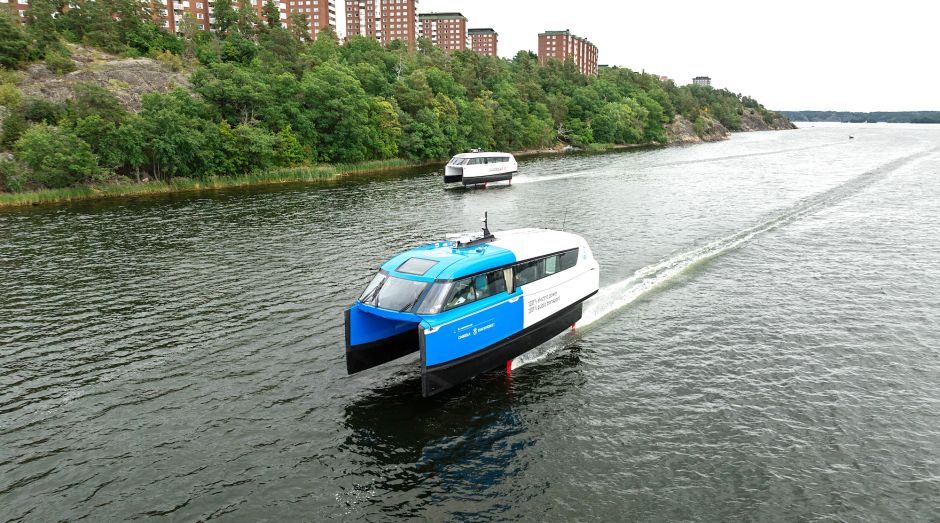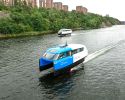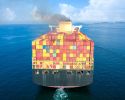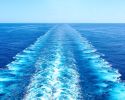New study: Electric commuter boats could streamline Stockholm’s public transport

The future of commuting in Stockholm may take place less underground and on roads—and more on the surface of Lake Mälaren. A new pre-study, funded by the Swedish Transport Administration, shows that fast electric commuter boats attract many travelers and could relieve pressure on the city’s other public transport systems. The question, however, is whether it is economically viable.
As traffic jams snake along the Essingeleden highway and the metro is overloaded, researchers are turning their gaze to the water. In the project Waterborne Urban Mobility (WUM), Henrik Sjöstrand and Chengxi Liu at VTI used a traffic simulation model that allows them to analyze how new boat systems affect passenger flows, travel times, and benefits within the transport system. The goal? To understand how electric commuter boats could relieve the city’s roads—and whether they are actually worth the investment.
Two concrete scenarios were tested.
The first: a new version of Line 89, running between Ekerö and Klara Mälarstrand, with a revised timetable. Here, the new Candela P-12—an electric boat with space for 25 passengers—was simulated. It is significantly faster (25 knots) than today’s boats on the line.
The second: a completely new route between Lilla Essingen and Liljeholmen, a short distance serviced by electric Cstrider ferries traveling at a modest 4–5 knots.
“The simulation model is based on Stockholm’s population and contains extensive data on current travel habits. First, we tested it by recreating the present situation—that is, comparing the model’s results with actual travel patterns today, for example on a boat line,” says Henrik Sjöstrand.
At its core, the model assumes that people choose the most optimal way to get from point A to point B. The so-called “boat factor”—the idea that the environment and atmosphere on board can make the trip more attractive—was not considered in the model. Apparently, it wasn’t necessary: on Line 89, the number of passengers increased from today’s actual roughly 400 to about 2,000 with Candela’s simulated boats.
“That was surprising. But it is probably because there are more departures, which is needed since Candela’s boats are smaller, and because the trip is much faster. The results from both scenarios show that more frequent departures and faster ferries increase the number of passengers, especially during morning and afternoon peaks.”
Henrik Sjöstrand emphasizes, however, that the numbers should be seen more as a trend than an absolute truth. Random variations in the model make it difficult to draw firm conclusions about smaller effects. A more robust result would require a larger study.
The researchers therefore suggest that the next step should be to simulate the entire network of boat connections—not just individual lines. Only then can the project’s core question be addressed, and a socioeconomic analysis of water-based public transport conducted.
“Increasing passenger numbers does not automatically mean that electric commuter boats like the Candela P-12 and Cstrider are economically viable. Many boats would be required, and the costs could, in practice, become too high.”
The pre-study Waterborne Public Transport was conducted by Henrik Sjöstrand and Chengxi Liu, both at VTI.
-
 Ny studie: Eldrivna pendelbåtar kan effektivisera Stockholms kollektivtrafik
Ny studie: Eldrivna pendelbåtar kan effektivisera Stockholms kollektivtrafik -
 EU: Sjöfartens utsläpp ökar
EU: Sjöfartens utsläpp ökar -
 Sociala relationer påverkar val av bränsle
Sociala relationer påverkar val av bränsle -
 Sjöfartens omställning kräver ”mjukare” påtryckningar
Sjöfartens omställning kräver ”mjukare” påtryckningar -
 Hon hade avtalad tid med Kapten ynkrygg
Hon hade avtalad tid med Kapten ynkrygg -
 Lighthouse omvärldsanalys 2025 – osäkerhet och tullar präglar sjöfarten
Lighthouse omvärldsanalys 2025 – osäkerhet och tullar präglar sjöfarten -
 Se seminariet Shipping in the Marine Environment
Se seminariet Shipping in the Marine Environment -
 Vad betyder egentligen de 90 procenten?
Vad betyder egentligen de 90 procenten? -
 Hålla där...
Hålla där... -
 Ny rapport: Klimatförändringarna ett hot mot de flesta större hamnar i världen
Ny rapport: Klimatförändringarna ett hot mot de flesta större hamnar i världen

